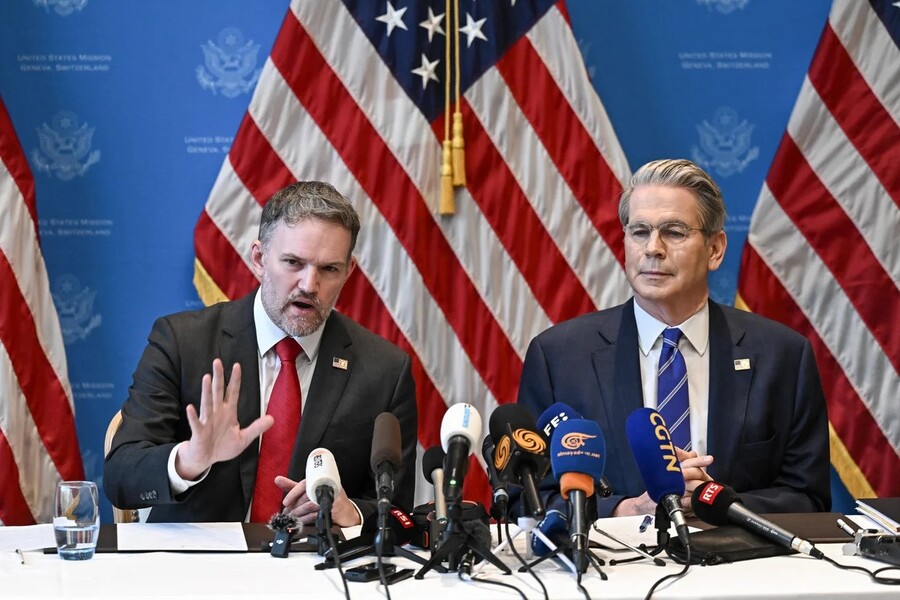In a significant de-escalation of trade tensions between the world’s two largest economies, the United States and China have agreed to a 90-day suspension of most of the punitive tariffs levied over recent months, the White House announced early Monday. The deal, revealed in a joint statement, marks a crucial breakthrough in the high-stakes economic negotiations that intensified over the weekend in Geneva.
U.S. Treasury Secretary Scott Bessent, speaking from Switzerland, confirmed that both countries will reduce their respective tariffs by a total of 115 percentage points over the three-month period. This temporary reprieve is aimed at allowing more room for negotiations and preventing further economic damage from what has been described as a modern trade embargo.
As part of the agreement, U.S. tariffs on Chinese imports will drop to about 30%, down from an average rate of 145%. Meanwhile, China’s tariffs on American goods will decline to 10%, down from 125%. The reductions are expected to unfreeze stalled trade routes, particularly at U.S. ports where cargo activity had plunged amid the tariff standoff.
“We have reached an agreement on a 90-day pause,” Bessent said, emphasizing that neither side desires economic decoupling. “What had occurred with these very high tariffs was essentially an embargo. Neither side wants that. We want trade. We want balanced trade.”
According to High Frequency Economics, China also signaled a willingness to ease non-tariff barriers, potentially resuming exports of rare earth elements — critical to the production of semiconductors and electric vehicle batteries — to the United States. These strategic materials had become a flashpoint in the trade war, threatening supply chains in key tech and green energy sectors.
President Donald Trump, speaking briefly before departing for a Middle East trip, hailed the accord as a move toward opening the Chinese market further. “The biggest thing that we’re discussing is the opening up of China, and they’ve agreed to do that,” Trump said. “But it’s going to take a while to paper it.”
The trade war, which intensified in early April with tit-for-tat tariffs, brought global trade between the two superpowers to a virtual standstill. U.S. levies of 145% on Chinese imports — and China’s 125% retaliatory duties — led to a slump in cargo shipments, rattled markets, and ignited fears of long-term decoupling. The latest agreement attempts to reverse some of that damage and restore faith in open trade dialogue. As noted by Bessent, the weekend consensus in Geneva was clear: “Neither side wants a decoupling.”
News of the agreement sent a jolt of optimism through global markets. Dow futures surged by over 1,000 points ahead of Monday’s opening bell. S&P 500 and Nasdaq Composite posted pre-market gains of 3.2% and 4%, respectively. Commodity and currency markets across Asia experienced strong rallies, buoyed by reduced fears of prolonged economic conflict. The rally reflects investor relief that a potential trade meltdown, which had weighed on projections for global growth, might be avoided, at least temporarily.
Despite the positive turn, analysts and economists are cautious about the durability of the truce. Wei Yao, head of research for the Asia Pacific at Société Générale, warned that strategic shifts — such as Washington’s efforts to reduce reliance on Chinese critical materials — might outlast the current détente.
“We are skeptical,” Yao said. “The thinking on reducing reliance on China for the supply of critical material seems more permanent, even though the U.S. may not mind continuing to buy clothes, toys, or even iPhones from China.”
According to UBS Global Wealth Management, U.S. tariffs on Chinese goods are likely to stabilize at 30–40% in the long term. Meanwhile, the Yale Budget Lab estimates that Americans still face an average effective tariff rate of 17.8%, the highest since 1934, highlighting the deep economic impact of the current protectionist trend.
The tariff pause with China follows another significant trade policy development: the U.S. recently reached an agreement with the United Kingdom to reduce tariffs on British car imports from 27.5% to 10%, and eliminate duties on steel and aluminum. These moves suggest the White House may be softening its previously aggressive protectionist posture, at least temporarily, in favor of a more strategic and calculated engagement with global partners.
While the 90-day tariff suspension marks a notable easing of hostilities, the road ahead remains complex. The U.S. and China must now use this window to address structural concerns like market access, intellectual property protections, and industrial subsidies. They must also avoid relapses into retaliatory measures that could reignite economic uncertainty and develop mechanisms for ongoing dialogue that offer predictability and transparency to businesses caught in the trade crossfire.
A successful outcome could shift the tone of U.S.-China relations for years to come. Failure, however, risks deepening the divide — not only between Washington and Beijing but across a global economy increasingly influenced by strategic rivalry.
What happened? The U.S. and China have agreed to a 90-day suspension of major tariffs to allow for continued trade negotiations. Why does it matter? The truce reduces immediate economic tensions and revives trade flows between the two countries, calming global markets. What’s next? Talks will continue to resolve broader trade issues, but uncertainty remains about whether this temporary pause will lead to a lasting deal.
